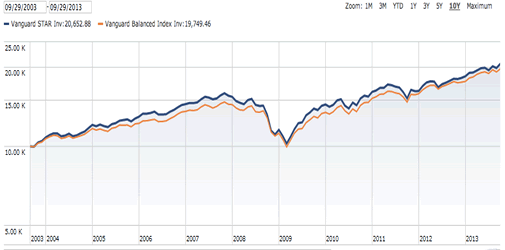I previously wrote about how the Vanguard Balanced Index Fund was a good example of the benefits of holding both stocks and bonds in your portfolio. Now, I’d like to extend this and compare the Vanguard Balanced Index Fund (VBINX) with another veteran balanced fund, the Vanguard STAR Fund (VGSTX). They are similar yet different:
| Vanguard STAR Fund (VGSTX) |
Vanguard Balanced Index Fund (VBINX) |
|
| Overall Asset Allocation | 60% Stocks 40% Bonds |
60% Stocks 40% Bonds |
| Expense Ratio | 0.34% | 0.24% (0.10% Admiral shares) |
| Geographic Exposure | Both US and international stocks, US bonds only | US stocks only US bonds only |
| Investment Style | Actively-managed, 11 underlying funds |
Passively-managed, cap-weighted index |
| 10-year annualized returns (as of 6/30/2013) | 7.22% | 6.86% (6.98% Admiral shares) |
Here’s a chart of how $10,000 invested 10 years ago would have done. With the Vanguard STAR fund, you’d have $20,653 today. With the Vanguard Balanced Index fund, you’d have $19,749. (This is with Investor shares, which have a lower minimum investment than Admiral shares. The minimum used to a lot higher, but now it is $10,000 for Admiral shares.)
My observations:
Asset allocation matters. Both funds are 60% stocks/40% bonds. But the STAR fund invests in 11 different underlying mutual funds, each with their own analysts carefully buying and selling securities as they see opportunities. These are some of Vanguard’s best managers, picked and pruned over time. Meanwhile, the Balanced fund just blindly follows an index, day in and day out. Yet the charts for both look very similar.
Active can beat passive over relatively long periods. Over the last 10 years, STAR has beaten Balanced by 0.36% (0.24% with Admiral shares, with a higher balance requirement). Even if you note that international stocks in general have outperformed domestic stocks over the last 10 years, Total International only beat Total US by 0.36% annually (8.31% vs 7.95%). Given that this would only have replaced about 30% of the fund (half of 60% stock holding), it would still roughly appear that the STAR fund may very well have created “alpha” over a long period. This is rare, but it still happens. I don’t know the exact risk-adjusted returns.
Costs still matter. STAR fund’s little bit of alpha is only possible due to the low 0.34% expense ratio. If the expense ratio was closer to the industry average for actively-managed funds, say 1% or another 0.66% more expensive, then that outperformance would have turned into underperformance. 7.22% minus 0.66% = 6.56%. I don’t know of any actively-managed funds that are cheaper than those at Vanguard.
Passive does really well without breaking a sweat. STAR might be able to do better in the future. It might not. If you like the idea of taking a chance of getting higher returns (meaning a chance of lower returns), then I don’t think holding STAR would be a bad choice due to its low costs and solid stewardship. However, I remain impressed by the seemingly effortless power of passive investing over the long run, despite all the smart people spending their lives trying to pick winners and ignore losers. Less stress for me is better. My portfolio remains predominantly passive and low-cost.

 The Best Credit Card Bonus Offers – 2025
The Best Credit Card Bonus Offers – 2025 Big List of Free Stocks from Brokerage Apps
Big List of Free Stocks from Brokerage Apps Best Interest Rates on Cash - 2025
Best Interest Rates on Cash - 2025 Free Credit Scores x 3 + Free Credit Monitoring
Free Credit Scores x 3 + Free Credit Monitoring Best No Fee 0% APR Balance Transfer Offers
Best No Fee 0% APR Balance Transfer Offers Little-Known Cellular Data Plans That Can Save Big Money
Little-Known Cellular Data Plans That Can Save Big Money How To Haggle Your Cable or Direct TV Bill
How To Haggle Your Cable or Direct TV Bill Big List of Free Consumer Data Reports (Credit, Rent, Work)
Big List of Free Consumer Data Reports (Credit, Rent, Work)
Wait, which one is actively managed?
I’ve procrastinated for so long on these two funds because of the $75 brokerage fee. I’m just not interested in opening a Vanguard account. Its amazing to me that there are no ETF alternatives…..and there genuinely seem to be none.
Just as a follow up to that last post I was wondering if anyone had an opinion about FPURX (Fidelity Puritan Fund) as an alternative to the Vanguard funds mentioned here.
There seems to be conflicting info on which is active and which is passive. The comparison chart says STAR is passive but the rest of it says its active. ??
I think you switched the column headings.
Whoops! Fixed the chart, sorry folks. STAR is actively managed, Balanced Index is passive.
@Beale – Most actively managed funds don’t have ETF alternatives, although a few like PIMCO Total Return ETF are popping up. You can replicate the balanced index fund quite easily with 60% VTI and 40% BND and rebalancing back to 60/40 regularly.
double ur money in 10 years, where else real estate u bleed in 10 years
Jonathan, I normally love you posts and I agree with the general points you make here, but you made a few mistakes.
The STAR fund had a standard deviation of 9.49% and the balanced fund 8.00% (VG website). Doing a simple T-test, the p = 0.95, i.e. there is no statical difference between the funds. There is no alpha in this comparison. Moreover, STAR is close to a “closet” index, so this example isn’t a great case of active vs passive.
It is indeed a challenge to strike the right asset mix and shuffling it from time to time depending on your needs – and that’s exactly why I choose Vanguard funds. Need to do some research on STAR, it seems like a great deal. Any resources that you’d suggest.